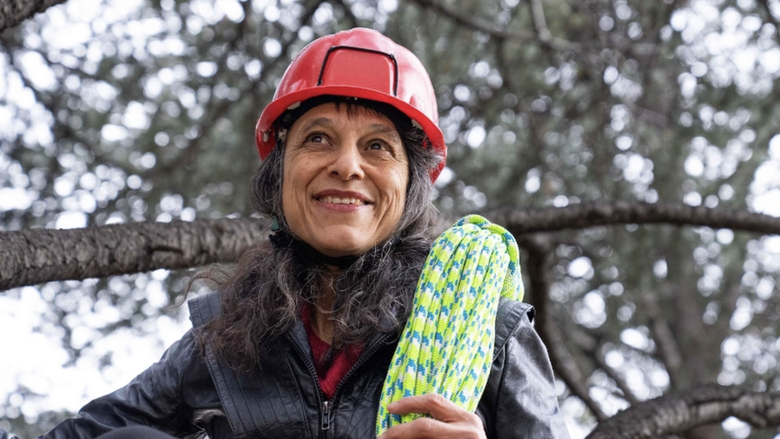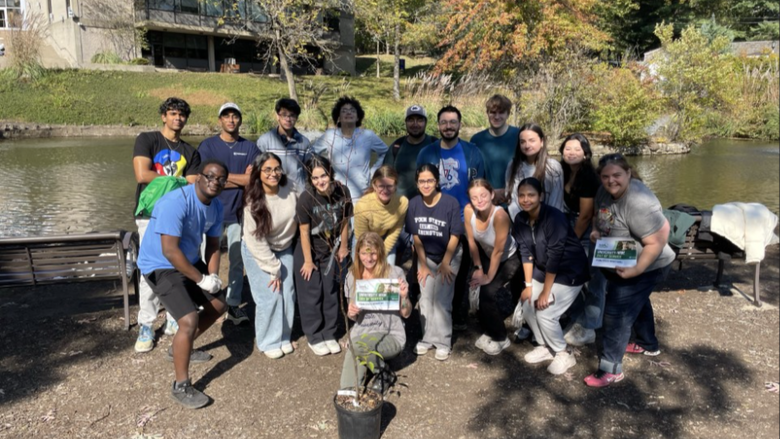
"Old Bay Guys" by artist Maggie Creshkoff.
MALVERN, Pa. — Since early April, Penn State Great Valley has been home to a lot of trash talk.
The campus’ Henry Gallery is currently showing "The Trashy Women Turn Twenty," an exhibit featuring work by eight regional artists who turn waste materials into art.
The Trashy Women describe themselves as “a collective of artists who gather the detritus of the world and turn it into something beautiful.” The group comprises a range of artists, from painters to ceramicists to welders. Their mission, according to their artist statement, is threefold: “to find unexpected beauty in the discarded and rejected, to share with others through teaching and exhibition, and to encourage each member to develop her own artistic potential.”
Becky Stanko, sustainability and community impact specialist at Penn State Great Valley, said that while seeing visitors’ responses to each exhibit at the gallery is always interesting, this exhibit has generated particularly poignant discussions.
“With this one, the dialog is much broader than being just about the art,” she said.
The pieces can be appreciated simply as whimsical, lovely or provocative works of art. But the fact that they are made from things that have been thrown away may encourage viewers to consider the profusion of waste that surrounds us, which aligns with United Nations Sustainable Development Goal 12: responsible consumption and production.
“Visual arts provide an entirely different way of approaching people,” Stanko said. “They reach people who are visually oriented, or who aren’t necessarily as moved by STEM data. That’s something we’re trying to capitalize on.”
Stanko said that a highlight of the opening in early April was watching attendees discover what some of the pieces were made from.
“I couldn’t immediately recognize many of the materials artists had used, but at the opening, I overheard people pointing them out,” she said. “It was shocking to me to recognize what things used to be and what they are now.”
Stanko described how some of the artists have created designs on objects that don’t normally have any ornamentation.
“One piece is made from a propane tank, which I hadn’t even realized until my husband said that it was his favorite,” she said. “The way that it’s welded and decorated — it just looks so beautiful.”
Another artist in the show painted on cardboard shipping boxes. “And they’re breathtaking,” Stanko added.
“It’s intriguing that you can pick out what you know from your own pantry, or your own life,” she said. “And it is cool hearing people talk about that.”
So far, the show has primarily been attended by the community at large and by corporate clients who rent conference space at Penn State Great Valley. Stanko sees this as one of the gallery’s primary assets.
“Visitors don't necessarily know everything that we're doing on campus, so when they walk in, we can expose them to our different partnerships and projects,” she said.
She added that faculty and staff have also shown considerable interest in the show. “A lot of people have let me know that they made time to visit the show, which doesn’t typically happen — so that’s been wonderful.”
Most of the work in the show is for sale, though many pieces have already sold. “The Ultimate Trashy Woman,” a piece sculpted by artist Maggie Creshkoff, stands out as one of the most notable items that is not available for sale. This trashy woman wears a skirt fashioned from the horn of an old Victrola, with a body made from a vintage Illy coffee can. Her head is a miniature globe — perhaps a nod toward the need to think globally each time we throw something away.
“There’s so much waste everywhere — it’s overwhelming,” Stanko said. “But it’s helpful to think that there is something we can do with it that is going to enhance our lives.”
"Trashy Women Turn Twenty" will be at the Henry Gallery through June 3. Located on the second floor of the Penn State Great Valley Conference Center, the gallery is free and open to the public Monday through Friday from 9 a.m. to 5 p.m.



